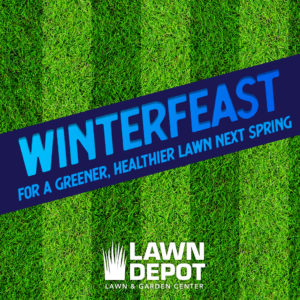
Fertilizing with LAWN DEPOT WINTERFEAST TURF FOOD – This is the most important feeding of the year for lawns. Cooler overnight temperatures have slowed top growth of our lawns. Soil temperatures are significantly warmer than air temperatures, allowing roots to continue to grow nicely as vegetative growth of lawns becomes slower. Lawns fed at this time of the year will use the nutrients absorbed now to build better, deeper roots this fall. They will also hold onto this stored energy until early next spring, displaying a greener, thicker lawn long before others that haven’t received the benefits of WINTERFEAST. If you fed the lawn in September or early October, withhold the WINTERFEAST feeding until around Thanksgiving; if you haven’t fed the lawn yet this fall, apply WINTERFEAST anytime now.
Late Fall Seeding – Because of the recent rains and continued mild overnight temperatures, we’re finding that seed continues to germinate nicely as we enter November. At the Lawn Depot, we modify our seed mixes as we get deeper into late fall, adding more EVERGREEN perennial ryegrass to our hybrid Tall Fescues in our preferred SURVIVOR MIX, calling it SURVIVOR 2. The later seed is applied the more EVERGREEN perennial ryegrass should be used to the point that applying 100% EVERGREEN is the best option. At this point we’re still encouraging late seeding and/or overseeding, by adding PENN MULCH or TACK STRAW to thin/bare areas to hold the seed in place and keep it moist. We also encourage you to regularly water seeded areas through germination at this time.
Mowing & Leaf Removal in November/December – Your grass is not growing very fast right now, but it is still growing. It is important that you continue mowing, albeit less frequently (maybe once/10-14 days) until all growth ceases for the season. Grass that is close mown when it goes dormant looks better all winter, greens up faster in the early spring, and is less susceptible to potential winter turf diseases like snow mold. Leaves will continue to blow in from adjoining properties, and will for the rest of the winter. These leaves will do little harm after the lawn is dormant, but until then, they can be matted down and smother the lawn, particularly any young grass in the lawn. After the last of the trees on your lawn have shed their leaves, there’s no reason to rake or vacuum the leaves, but you ought to chop any leaves that blow in by mowing.
Late Fall Liming – All lawns benefit from regular liming to neutralize our typically acidic soils. Soils that are maintained at a pH level of 6.3-6.5 (slightly acidic) are ideal for growing healthy turf. Fertilizers work better in slightly acidic soil. The lower (more acidic) the pH, the less effective the fertilizer, as the nutrients become chemically bound with the soil and are less available for plants to uptake. Liming of lawns should be done EVERY year. The lime product we recommend and offer at Lawn Depot’s Garden Center (Cal-Turf Pro™) is clean and easy to handle, goes through a broadcast spreader easily and isn’t at all dusty. Cal-Turf Pro™ (a fast-acting lime) which is applied at 5 lbs./1,000 sq. ft. for maintenance applications or 12 lbs./1,000 sq. ft. to increase pH. Cal-Turf Pro™ is more effective than dolomitic limestone in raising soil pH. It begins to neutralize soil acidity immediately, resulting in soil pH increases that can be measured in weeks rather than months, thus promoting better root development, vigor and growth, as well as drought and stress tolerance.
